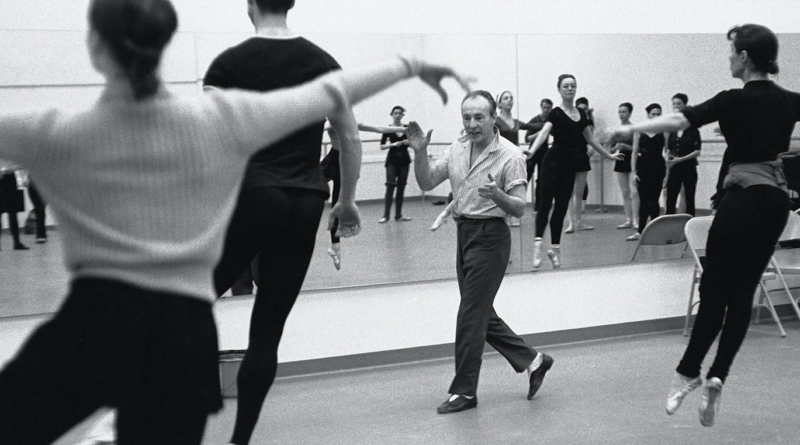INTERVIEW: New documentary let’s you go ‘In Balanchine’s Classroom’
Photo: George Balanchine teaches at the New York State Theater in Lincoln Center, circa 1964, as seen in In Balanchine’s Classroom, a film by Connie Hochman. Photo courtesy of Martha Swope / Provided by Zeitgeist Films in association with Kino Lorber with permission.
George Balanchine, one of the most influential choreographers of all time, lived a full life of dance and cultural impact throughout the 20th century. He was born in 1904 and died in 1983, having lived through momentous decades of war, struggle, triumph and success. His life is the subject of a new documentary called In Balanchine’s Classroom, now playing at New York City’s Film Forum.
For director Connie Hochman, the idea for the documentary started hatching in 2004-05. In the early days, she reached out to the George Balanchine Trust and also a former dance teacher of hers who worked for the School of American Ballet, which was founded by Balanchine (he also founded the New York City Ballet).
“I had to kind of bounce the idea off these sources,” Hochman said in a recent phone interview. “They were encouraging, and then it was trying to get the Balanchine dancers to start talking to me.”
Hochman and her husband started filming the interviews after they had an agreement in place with the trust, which owns the rights to Balanchine’s choreography. There was a sense of urgency because many of the choreographer’s dancers are much older now, and the director wanted to make sure their unique stories were captured on film.
“I think it’s 24 of Balanchine’s dancers have died since I started the interviews,” she said. “We did get some of these interviews right in the nick of time because obviously they are getting older. The other thing is that as I was doing the interviews, people were saying to me, ‘You’ve done enough,’ after 10 some people. … I kept it in the back of my mind imagining if we don’t get somebody, and they have these incredible memories of the classes and interactions, we’ve lost something. So I wanted to get every single dancer who had shared their memories and insights, and it did happen that of the 100 or so interviews, there are no two that are alike. They are like night and day because their personalities are so different, and their minds and their bodies, what they were up against trying to master this technique on a level that only Balanchine taught it. It was just a different experience for each one of them, and they’re performers. So they would express themselves differently, so I’m glad I did the interviews. And we’re going to do an archive. We’ve already begun work on an archive so that they will be available.”
Throughout the entire project, Hochman, who is a dancer herself, kept one edict in mind: she wanted to relay exactly what the performers shared with her. Some dancers used the word “childlike” when describing the choreographer’s technique. They remembered him creating dancers as if he were a little boy playing with a train set or blocks.
“It was his playtime,” the filmmaker said. “He was in his element, in the moment and having fun. … Of course, he knew the scores inside and out. He was a musician before he was a dancer, and he studied the score. He knew every beat. He could talk about the score with the conductor as knowledgeably, if not more. The motivation was the music, so once he was in the room after knowing everything you could know about the music, he was free to just take their potential and just blast off.”
The Balanchine documentary captures the voices of many important dancers, including Jacques d’Amboise, Merrill Ashley, Gloria Govrin, Suki Schorer, Edward Villella and Heather Watts, according to press notes. They collectively were impressed by Balanchine’s life story of having immigrated to the United States and achieved his dreams as an artist.
“The dancers loved talking about this, from the very earliest dancers all the way through,” Hochman said. “[After he arrived], he was not going to have any place but New York City to start School of American Ballet, which was going to give rise to a company. Yes, he loved the energy of the city, the pace. He also just loved the American spirit and the vastness of the country and the healthy bodies. He was coming over in 1933, and Europe was a wreck. And the dancers describe how he was just so — I don’t want to misconstrue — but kind of turned on by the energy and the healthiness, the robust, strong American bodies. He just saw unlimited potential, the American spirit, freedom of expression. … He loved a lot about this country and specifically New York City.”
By John Soltes / Publisher / John@HollywoodSoapbox.com
In Balanchine’s Classroom, produced and directed by Connie Hochman, is now playing New York City’s Film Forum. Click here for more information and tickets.

